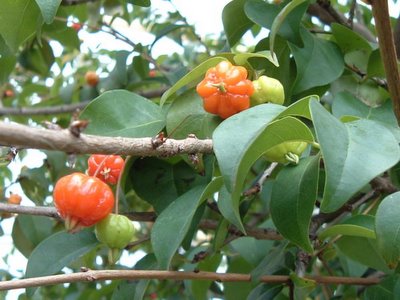“The Pitanga tree forms a large shrub or a small tree approximately 20 feet in height. The small, opposite, ovate-lanceolate leaves are glossy green, but immature leaves have a coppery color that adds to the ornamental value of this plant. The Pitanga tree makes an excellent hedge, flowering and fruiting even when severely pruned."
"The fruits are about 1 inch in diameter (2.5 cm), although plants bearing fruits nearly 2 inches in diameter have been reported. The mature fruit range from light to dark red. The juicy sweet-acid pulp encloses 1, or sometimes 2, fairly large seeds. Pitanga is probably the best of the edible eugenias and is an excellent fresh fruit. The pulp is a good source of calcium, and a fair source of phosphorus and iron.”
 Photos by Sonia de Amorim Mascaro
Photos by Sonia de Amorim Mascaro
The Pitanga, which are now grown in the U.S., are slightly acid and are eaten fresh, out-of-hand and also can be used to make pies, jellies and jams.
Propagation: It is usually propagated by seeds, cuttings are reportedly easy, and cleft grafts also have been used successfully.
Another specie of Pitanga is the Savannah Pitanga (Eugenia calycina ), also native to drier savannah and scrub land regions of Brazil.

Photo by www.wikipedia.com




Sonia-- The photograph of the tree outside your studio is so idyllic.
ReplyDeleteThe fruits look delicious. Do you make jam? Or do you prefer just picking and eating right from the tree?
Thank you for sharing the delights of a Brazilian orchard with us. You must really love living in such a beautiful place with so many large trees.
ReplyDeleteWhat pretty fruits they are. Thanks you for sharing with us.
ReplyDeleteYour pitanga tree is gorgeous. I had one of these trees growing by the front door of a house I used to live in here in tropical Queensland, Australia. My tree was just a shrub, though: I never knew they could be so magnificent.
ReplyDeleteWhat lovely trees from your studio!! Actually your blog is beautiful with all the different trees! I must bookmark your blog! Thanks for visiting mine....PJ
ReplyDeleteNice pictures.....I love trees....I have a few in my yard, but it's the ones that are so different that I really love. You said the Surinam Cherry tree may have been started from a seed dropped by a bird.....I have so many things that I am watching, and wondering if it is a tree....little sprout that have grown a couple feet high, and look like a tree.....but it could be wishful thinking.....
ReplyDeleteSo, so beautiful! So lush compared to my part of the world right now. I've very envious of your lychee tree.
ReplyDeleteHi Sonia! Wow. I love, love, love your pictures. Very beautiful. Thanks for sharing them. I'm sure you are inspiring many to travel to Brazil!
ReplyDeleteI love seeing all these unfamiliar fruits!
ReplyDeleteWhat a view from your studio! The pitanga tree is beautiful & its fruit looks scrumptious. Paradise. Always like a vacation to visit you.
ReplyDeleteI just found your blog from your comments on mine. Thanks for sharing your photos--it is interesting to find out what's growing in another part of the world!
ReplyDeleteThanks for all the wonderful comments on my blog Sonia. I really appreciate it. Love your site and your place. Looks like a peaceful place to live!
ReplyDeleteTammie
http://graffitidreams.typepad.com
We have a native Eugenia in Australia too (maybe several of them). Here they are called the Lilly Pilly. Birds love them, and they make a mess on footpaths, and occasionally I have heard of a jelly/jam made from them - but we do not usually eat them.
ReplyDeleteSo, Sonia - when are you planning to export these great fruit trees to Australia?
ReplyDeletewhat a beautiful tree. How nice to have it outside your studio window.
ReplyDeletenever seen or taste it. hmm very interesting.
ReplyDeletehi sonia, it's me again. i always do bloghopping. i guess thats how i found you :)
ReplyDeleteif you don't mind i want to add your url in my list :)
Anytime I want to escape from rainy London, I can come to your blog Sonia. Thank you for sharing this beauty with us.
ReplyDeleteThanks, everyone, for your generous comments!
ReplyDeleteWe had these "cherries" where I grew up in Florida. I can still remember the sweet, tart taste. Thanks for the memory! One of the best things about bloging is the links which is how I found yours.
ReplyDeleteSonia - what a beautiful place you live in, with the water and all these gorgeous trees. There are so many that are foreign to me, who lives in the northern hemisphere. Thanks for visiting my blog so I could meet you. I look forward to visiting your lovely garden regularly!
ReplyDeleteOh, and you mention a studio - ate you an artist too?
Thats interesting about the pitanga tree Sonia, looking up in my native plant book I see a group of trees we call Lillypillys used be to called Eugenias (now called syzygium) The leaf on yours looks similiar, and we can also make jam from the fruit. They are great trees for the garden, yours looks very comfortable.
ReplyDeleteBeautifull tree! I came to this site because someone told me that Pitanga's leaves lower the cholesterol. Is that true?
ReplyDeleteHi Lucy, yes, Pitangas lower the cholesterol because Lycopene is an antioxidant agent. "Lycopene is considered the carotenoid that has the highest capacity of capturing the singlet oxygen. Free radicals are continuously acting on the organism, being capable of promoting cellular damage and development of cancer among other chronic diseases. Studies show that lycopene protects lipid molecules, low-density lipoproteins, proteins and DNA against the attack of free radicals. They have an essential function in the protection against diseases. As a precaution, one should eat foods that are a source of lycopene: tomatoes and tomato-products (purée, pasta, ketchup), papaya, pitanga and guava; to provide approximately 35mg of lycopene a day." Rev. Nutr. vol.17 no.2. Campinas Apr./June 2004,by
ReplyDeleteNajua Juma Ismail Esh Shami and Emília Addison Machado Moreira.
http://www.scielo.br/scielo.php?pid=S1415-52732004000200009&script=sci_arttext&tlng=pt
I would love to pick those cherries off...I have a thing for cherry trees. I think it is that vivid red color!
ReplyDeleteWonderful photos...as you always do...I hope you enjoy your weekend!
here i am 5 years after you made this post! just read about the jaboticaba from the link you sent me [i hope i remember the name right] and came here after.
ReplyDeletethis fruit looks just like something that i've seen in packets in asian supermarkets. how odd. i wonder if they're the same, though those look more bright yellow, maybe because they're preserved.
i am seriously also wondering how the jaboticaba tastes like, from your description. one day...
:) xox
Pitanga is a delicious, cherry-like fruit that grows on a large bush to small tree. It will fruit when placed in a large pot. It's reportedly hardy to 22 F (-5 C). In fact, a friend of who's from Suriname has given me a grafted seedling last year.
ReplyDelete